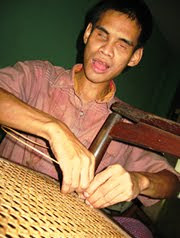skip to main |
skip to sidebar

From
IRIN News:
YANGON, Myanmar - Myanmar has one of the highest rates of blindness in Asia, yet the country has scant resources to help visually impaired people, medical researchers and aid workers say.
The World Health Organization (WHO) in 2008 identified avoidable blindness as an emerging health issue in the country, while aid organizations say it is a major public health concern in impoverished rural areas.
Researchers and aid workers say there is a lack of eye care services and resources in Myanmar.
According to the Vision Myanmar Programme, a training and research project run by the South Australian Institute of Ophthalmology, there are only 200 eye surgeons or ophthalmologists for Myanmar’s population of over 50 million. Most are in Yangon and Mandalay. Outside of these two cities, there is one ophthalmologist for every half a million people, it said.
“Of course there is a shortage of doctors… There simply aren’t enough surgeons,” the programme’s founder, Henry Newland, told IRIN from Adelaide, Australia.
The Vision Myanmar Programme started a four-year programme in 2008, primarily funded by AusAID, to provide training for eye surgeons, as well as provide equipment and facility upgrades.
In 2005, the programme conducted a population-based blindness survey of over 2,000 people in rural villages in central Myanmar and identified a blindness prevalence rate of 8.1 percent among people over 40, which it said is the highest published rate in the world.
And according to 2001 figures published by WHO, Myanmar had a blindness prevalence rate of 0.9 percent of its population, among the highest in the region. Thailand had a blindness prevalence rate of 0.3 percent, while India’s was 0.7 percent.
Most of Myanmar’s visually impaired people suffer from avoidable blindness, which can either be treated or prevented. Cataracts are the leading cause of blindness, followed by glaucoma, while Vitamin A deficiency causes blindness in children.
“Eighty percent of these cases are avoidable by either preventive measures or curative measures, surgery,” said Newland.
Hoping to make a living, Myo Myint Oo (pictured) studied cane weaving for several years. Despite his efforts, the blind 39-year-old has been unable to find anyone to employ him.
Unable to feed or shelter himself, Myo Myint Oo is forced to rely on the government-run School for the Blind (Kyimyindine) in Yangon, where he learnt the cane craft.
"I want to stand on my own feet … But how can I, when nobody wants to employ a blind person like me?" he said.
Like other disabled groups, blind people in Myanmar are stigmatized as unproductive members of society and find it difficult to live independent lives.
"Visually impaired people are still being isolated and excluded from society, “Maung Maung Tar, the principal of the school, told IRIN, adding that there was a need to change attitudes to the affliction.
Myanmar has a policy of inclusive education, which means disabled students, including those who are blind, are allowed to attend classes in mainstream schools.
However, there are challenges to implementing the policy, since schools lack the required resources and facilities.
“The schools should be equipped with teaching materials in Braille, and teachers who know how to teach the blind by using Braille,” said Thein Lwin, the general secretary of the Myanmar Christian Fellowship of the Blind (MCFB) NGO, which runs two schools for the blind.
Despite official policy, mainstream schools are not properly equipped to cater for blind students, meaning that most children are forced to attend specialist schools. However, there are just seven state and NGO-run schools for blind children in the whole country, where over 700 blind and visually impaired students receive a formal or vocational education.
Few options
Although a small percentage of blind students strive for as much education as possible, most do not finish high school.
"There are almost no job opportunities for blind graduates, which discourages them from pursuing higher formal education," said Aung Ko Myint, secretary-general of the Myanmar National Association of the Blind (MNAB).
"So, most of the blind prefer vocational education to formal education," he said.
In an effort to help the blind find jobs, organizations provide vocational training. But there are commonly just two types of vocational training on offer - cane craft and massage - leaving blind people with few career options, experts complain.
“We should create different kinds of vocational courses (for the blind) so they can get more choices,” said the MCFB’s Thein Lwin.
 From IRIN News:
From IRIN News:
